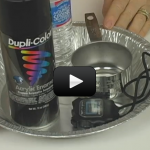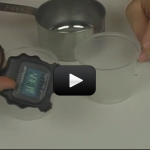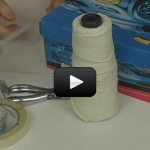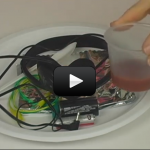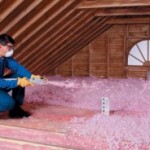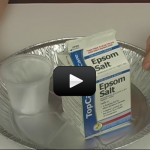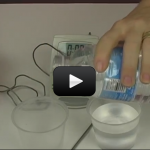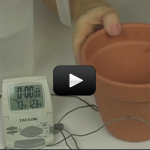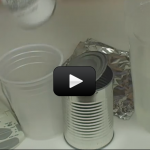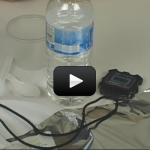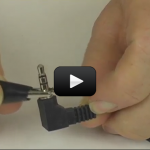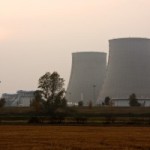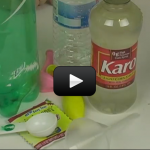Special Science Teleclass: Renewable & Alternative Energy
This is a recording of a recent live teleclass I did with thousands of kids from all over the world. I’ve included it here so you can participate and learn! Discover the world of clean, renewable energy that scientists are developing today! Explore how they are harnessing the energy of tides and waves, lean how … Continue reading "Special Science Teleclass: Renewable & Alternative Energy" |
How Much Energy Does the Sun Produce?
Without the sun, there would be no life on Earth. The sun warms the earth, generates wind, and carries water into the air to produce rain and snow. The energy of the sun provides sunlight for all the plant life on our planet, and through plants provides energy for all animals. The sun is like … Continue reading "How Much Energy Does the Sun Produce?" |
How Can Water Be Used to Store Heat Energy?
Temperature is a measure of the average hotness of an object. The hotter an object, the higher its temperature. As the temperature is raised, the atoms and molecules in an object move faster. The molecules in hot water move faster than the molecules in cold water. Remember that the heat energy stored in an object … Continue reading "How Can Water Be Used to Store Heat Energy?" |
Can Wind Be Used as a Source of Energy?
The United States has large reserves of coal, natural gas, and crude oil which is used to make gasoline. However, the United States uses the energy of millions of barrels of crude oil every day, and it must import about half its crude oil from other countries. Burning fossil fuels (oil, coal, gasoline, and natural … Continue reading "Can Wind Be Used as a Source of Energy?" |
Can a Battery Be Used to Store Energy?
A battery is a device that produces electrical energy from a chemical reaction. Another name for a battery is voltaic cell. Voltaic means to make electricity.Most batteries contain two or more different chemical substances. The different chemical substances are usually separated from each other by a barrier. One side of the barrier is the positive … Continue reading "Can a Battery Be Used to Store Energy?" |
Can Insulation Save Energy?
An insulator is a substance that partly blocks or slows the flow of heat through it. Styrofoam is a lightweight plastic used in drinking cups. Styrofoam is a good insulator. A cooler or ice chest that is made of Styrofoam or some other insulator tends to block the flow of heat through it. Heat flows … Continue reading "Can Insulation Save Energy?" |
Can a Salt Be Used for Heating and Cooling?
Cooling and heating are opposite processes. Cooling is the removal of heat energy from an object or space and heating is the addition of heat energy to an object or space. We use these opposite processes a great deal in our daily lives. For example, in the kitchen we use the cooling provided by a … Continue reading "Can a Salt Be Used for Heating and Cooling?" |
How Can Shade Trees Keep Things Cool?
Having shade trees around a house can decrease the cost of cooling the house with air conditioning. A house not shaded from the sun absorbs some of the light from the sun and heats up the outside surface of the house. If the house is poorly insulated, some of this heat will penetrate into the … Continue reading "How Can Shade Trees Keep Things Cool?" |
Can the Evaporation of Water Be Used for Cooling?
The evaporation of water for cooling purposes is called evaporative cooling. An important example of this type of cooling is the removal of body heat by humans through sweating. When your body needs to cool, perspiration is released to the surface of your skin where it evaporates. The evaporation of the water in the perspiration … Continue reading "Can the Evaporation of Water Be Used for Cooling?" |
Can Expanding Gases Be Used for Cooling?
In a typical air conditioning or refrigeration system, a liquid at high pressure is allowed to pass through a valve from a higher pressure to a lower pressure. As the liquid enters the lower pressure region, it changes from a liquid to a gas. This change causes a cooling effect. The liquid cools as it … Continue reading "Can Expanding Gases Be Used for Cooling?" |
Can the Sun Be Used to Heat Water?
The energy of sunlight powers our biosphere (air, water, land, and life on the earth’s surface). About 50 percent of the solar energy striking the earth is converted to heat that warms our planet and drives the winds. About 30 percent of the solar energy is reflected directly back into space. The water cycle (evaporation … Continue reading "Can the Sun Be Used to Heat Water?" |
How Can the Sun Be Used for Cooking?
Cooking involves heating food to bring about chemical changes. Sometimes foods are heated simply because the food tastes better warm than cold. In making tea, we sometimes heat water to help dissolve tea or help dissolve sugar if the tea is sweetened. Normally the water used to make tea is heated on a range top … Continue reading "How Can the Sun Be Used for Cooking?" |
Can Solar Energy Be Concentrated?
The curved shape of the magnifying lens causes light rays to bend and focus on an image. When we look through the lens, we can use it to make writing or some other object appear larger. However, the magnifying lens can also be used to make something smaller. The light from the bulb is bent … Continue reading "Can Solar Energy Be Concentrated?" |
Can Electricity Be Made From Sunlight?
The solar cell you are using for this experiment is made from the element silicon. Silicon solar cells consist of two thin wafers of treated silicon that are sandwiched together. The treated silicon is made by first melting extremely pure silicon in a special furnace. Tiny amounts of other elements are added which produce either … Continue reading "Can Electricity Be Made From Sunlight?" |
Can Water Be Heated With Composting Plant Material?
Fossil fuels, which include petroleum, natural gas, and coal, supply nearly 90 percent of the energy needs of the United States and other industrialized nations. Because of their high demand, these nonrenewable energy resources are rapidly being consumed. Coal supplies are expected to last about a thousand years. We must find other sources of energy … Continue reading "Can Water Be Heated With Composting Plant Material?" |
Do Plants Store Energy?
A peanut is not a nut, but actually a seed. In addition to containing protein, a peanut is rich in fats and carbohydrates. Fats and carbohydrates are the major sources of energy for plants and animals. The energy contained in the peanut actually came from the sun. Green plants absorb solar energy and use it … Continue reading "Do Plants Store Energy?" |
Can a Fuel be Made From Plant Material?
Yeast is a simple living organism that can break down sugars into ethyl alcohol (ethanol) and carbon dioxide. The process by which yeast breaks down sugars into ethyl alcohol and carbon dioxide is called fermentation. The tiny gas bubbles rising in the liquid mixture in the bottle are carbon dioxide gas bubbles that are made … Continue reading "Can a Fuel be Made From Plant Material?" |


